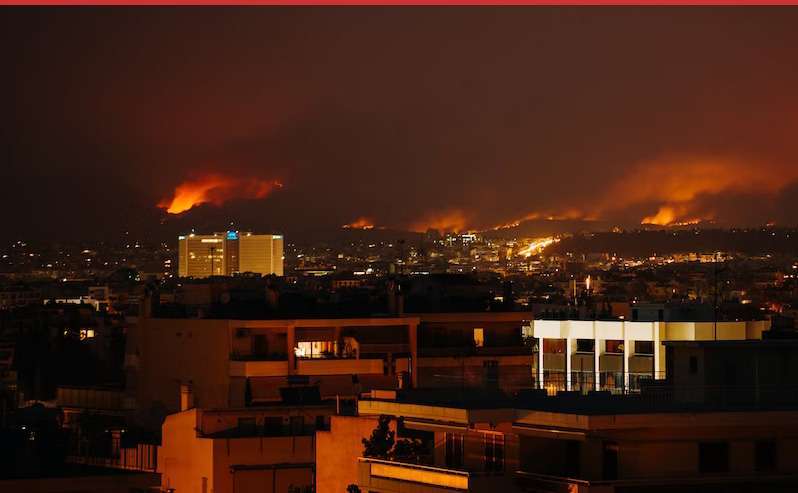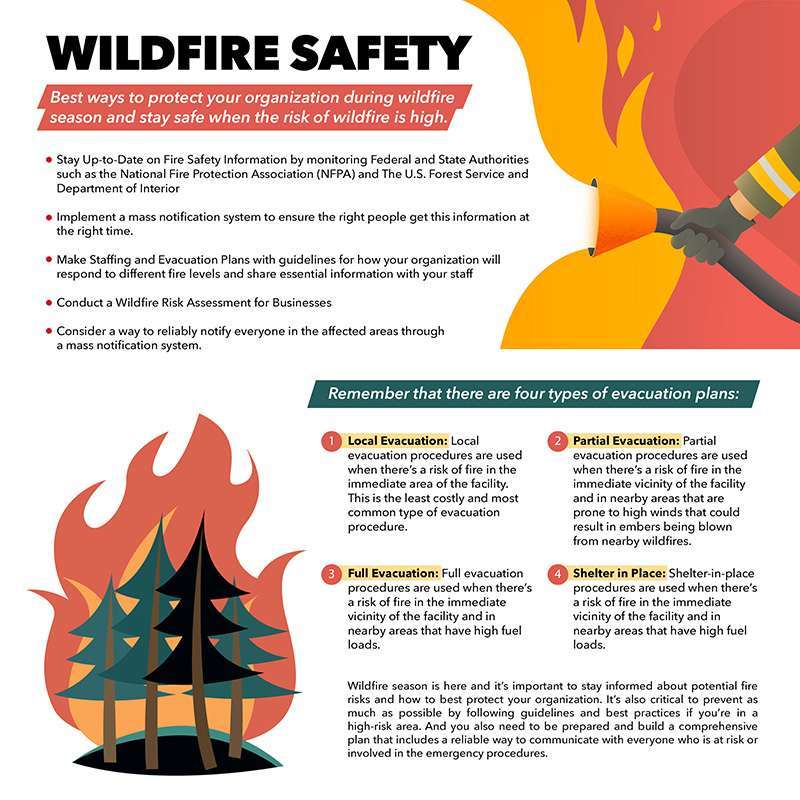
Best Ways to Protect Your Organization During Wildfire Season
Wildfire season represents a significant threat to areas throughout the United States. To help your organization get ready to handle the potential risks, Regroup has compiled our best tips for staying safe when the risk of wildfire is high. Wildfire season in much of the United States lasts from June to October and often coincides with hot and dry conditions that increase the likelihood of a fire outbreak. Luckily, there are steps you can take now to protect your staff, co-workers, assets and visitors during this critical time.
In this blog article, you will learn about the different types of wildfires, how to prepare for them, how a mass notification system can save lives and what you can do to reduce your risk of exposure—whether you work in a hot climate or not.
What to Know About Wildfire Season
Wildfire season typically begins in California in May and ends in October, although the start and end dates can vary from year to year. Fire season in the Southwest region lasts from June to October while in the Northwest and Rocky Mountain states, it begins in July and runs through September. Wildfires can happen at any time of the year, but the risk is highest during the summer months when the weather is warm and dry. The environment is a major factor in determining when wildfire season starts. Temperatures and humidity affect how much fuel is available to feed a wildfire. For example, the wild land-urban interface (WUI), which is where cities meet forests, shrub land and grassland, has a high risk of wildfire. Wildfire risk is also higher in areas that are prone to drought and have above-normal temperatures.
Stay Up-to-Date on Fire Safety Information
In order to stay informed about potential fire risks, and how to best protect your organization, it’s important to stay up-to-date on news and fire safety information from accredited fire safety organizations such as the National Fire Protection Association (NFPA). The NFPA publishes a seasonal report with best practices for handling wildfire risk at different times of the year. It’s also a good idea to check in with state or local officials to learn about any existing or potential threats in your area. The U.S. Forest Service and Department of Interior publish wildfire forecasts, as well as additional resources to help businesses prepare for wildfire season.
Implementing a mass notification system is crucial in order to ensure the right people get this information at the right time. Features like GeoFencing and automated alerts that are reliable and can be delivered even when emergencies occur and cell signals might be down, are critical in order to keep people and goods safe during wildfires.
Make Staffing and Evacuation Plans
If your business is in an area at risk of wildfire, it’s essential to make an evacuation plan. Develop guidelines for how your organization will respond to different fire levels and share essential information with your staff. Being able to quickly communicate these plans and instructions at a moment’s notice to all affected staff must be part of your planning. Consider conducting a tabletop exercise with your employees to test your plan and identify any areas that need improvement. A good rule of thumb is to establish evacuation procedures and guidelines for staff in areas where there is a high risk of wildfire, including areas adjacent to:
- National forests or areas designated as high-risk for wildfire.
- Areas that contain significant fuel loads such as shrub lands.
- Areas that have recently experienced significant wildfires.
- Areas that are prone to high winds that could result in embers being blown from nearby wildfires.
Conduct a Wildfire Risk Assessment for Businesses
If your business is located in an area at risk of wildfire, you should conduct a Wildfire Risk Assessment (WRA) to determine your organization’s risk of encountering a wildfire. The NFPA WRA provides a good guide for conducting a risk assessment. This assessment will help you identify and prioritize possible wildfire hazards in your area. It will also help you identify mitigation strategies to reduce the risk of wildfire from impacting your business. The WRA will be most helpful if you use it to create a specific plan for your business that accounts for its specific risks.
Have an Evacuation Plan
After you have evaluated your organization’s wildfire risk and made any necessary changes to reduce that risk, you should develop an evacuation plan for your facility. Every evacuation plan must contemplate a way to reliably notify everyone in the affected areas through a mass notification system. There are four types of evacuation plans: Local Evacuation, Partial Evacuation, Full Evacuation and Shelter in Place.
- Local Evacuation: Local evacuation procedures are used when there’s a risk of fire in the immediate area of the facility. This is the least costly and most common type of evacuation procedure.
- Partial Evacuation: Partial evacuation procedures are used when there’s a risk of fire in the immediate vicinity of the facility and in nearby areas that are prone to high winds that could result in embers being blown from nearby wildfires.
- Full Evacuation: Full evacuation procedures are used when there’s a risk of fire in the immediate vicinity of the facility and in nearby areas that have high fuel loads.
- Shelter in Place: Shelter-in-place procedures are used when there’s a risk of fire in the immediate vicinity of the facility and in nearby areas that have high fuel loads.
Protect Computer Equipment
Computers and computer equipment are often at risk of damage during wildfire season. Protect your computer equipment by following these best practices:
- Keep computers and computer equipment away from windows.
- Make sure the building is equipped with proper fire prevention equipment such as sprinklers, smoke alarms and fire extinguishers.
- Install properly grounded and rated equipment that is certified to UL standards.
- Keep computers and computer equipment unplugged and disconnected from the building’s network if an evacuation is necessary.
- Keep computer equipment in a safe, dry location.
- Choose a surge protector with a UL rating.
Your Next Steps
Wildfire season is here and it’s important to stay informed about potential fire risks and how to best protect your organization. It’s also critical to prevent as much as possible by following guidelines and best practices if you’re in a high-risk area. However, you also need to be prepared and build a comprehensive plan. This plan should include a reliable way to communicate with everyone who is at risk or involved in the emergency procedures. Schedule a free demo with Regroup to get started.
Table of Contents
Categories
- Regroup Product Guides
- Disaster Recovery
- Employee Safety
- Routine Communications
- Mass Notification
- Critical Event Management
- Emergency Preparedness
- Corporate
- Insurance
- Business Continuity
- Business
- Education
- Uncategorized
- Nonprofit
- Healthcare
- Hospitality
- Government & Public Services
- Our Clients
- Awards
- COVID-19
- Safety & Preparedness
- Announcements
